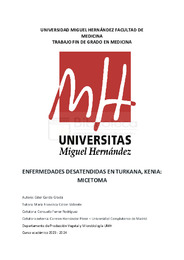Por favor, use este identificador para citar o enlazar este ítem:
https://hdl.handle.net/11000/33745Enfermedades desatendidas en Turkana, Kenia: Micetoma
| Título : Enfermedades desatendidas en Turkana, Kenia: Micetoma |
| Autor : García Graciá, Ester |
| Tutor: Colom Valiente, María Francisca |
| Editor : Universidad Miguel Hernández |
| Departamento: Departamentos de la UMH::Producción Vegetal y Microbiología |
| Fecha de publicación: 2024-05-04 |
| URI : https://hdl.handle.net/11000/33745 |
| Resumen : Introducción: El Micetoma es una enfermedad infecciosa crónica que afecta a la piel y el tejido celular subcutáneo y que conlleva una significativa discapacidad. Fue reconocida por la OMS como una Enfermedad Tropical Desatendida (ETD) en el año 2016. Debido a la falta de investigación, es crucial profundizar en el conocimiento del agente etiológico y su nicho en la naturaleza con la finalidad de mejorar su diagnóstico, tratamiento y prevención. Metodología: Se seleccionaron pacientes del condado de Turkana con diagnóstico clínico de micetoma, se recogieron datos clínicos y demográficos y se tomaron muestras. Todas las muestras fueron procesadas por cultivo (agar nutritivo, agar Sabouraud y medio Horikoshi), biología molecular, PCR y secuenciación para su identificación. Resultados: Se atendieron 41 pacientes de entre 12 y 80 años, mayoritariamente hombres (30; 73,17%) de los que se obtuvieron biopsias (23; 54,76%), exudados (4; 9,52%), punción aspirativa con aguja fina (11;26,19%) y 4 piezas quirúrgica (9,52%). La mayoría eran pastores (17; 41,46%); la localización de las lesiones más frecuente fueron los pies (35; 85,36%) y los pacientes, mayoritariamente utilizaban calzado abierto. El tamaño de la lesión y el tiempo de evolución de la enfermedad fue muy variado, con una moda de 6 años de evolución. En cuanto al color de los granos supurados a través de fístulas causadas por la lesión se dataron 11 granos negros (26,82%) y 18 blancos y amarillos (43,9%). Tras la extracción y amplificación del DNA de las muestras de pacientes y los cultivos realizados se identificaron microorganismos como Paraphaeosphaeria neglecta, Curvularia sp, Alternaria sp,Chaetomium convolutum o Streptomyces somaliensis que han sido descritos como agentes etiológicos de micetoma. Discusión: El estudio muestra la presencia de agentes reconocidos como causantes de eumicetoma y actinomicetoma descritos previamente en la literatura. A pesar de que podemos encontrar actinomicetomas, predomina el eumicetoma, siendo los hongos los responsables de producir dicha enfermedad. El método de recogida de muestra clínica que mejor resultado proporciona es la punción aspiración con aguja fina. El nuevo medio de cultivo utilizado, medui Horikoshi, permitió el aislamiento de microorganismos que no habían crecido en los medios convencionales, sin embargo, no eran agentes causantes de micetoma. Conclusión: El condado de Turkana (Kenia) tiene una elevada prevalencia de micetoma que afecta fundamentalmente a hombres de unos 30 años que se dedican al pastoreo y no llevan calzado o utilizan de tipo abierto. Introduction: Mycetoma is a chronic infectious disease affecting the skin and subcutaneous cellular tissue that leads to significant disability. It was recognized by WHO as a Neglected Tropical Disease (NTD) in 2016. Due to the lack of research, it is crucial to deepen the knowledge of the etiological agent and its niche in nature in order to improve its diagnosis, treatment and prevention. Methodology: 41 patients (42 samples) with mycetoma from Turkana County were studied. All samples were processed (culture, DNA extraction and PCR) and sequenced for identification. Results: 40 patients aged 12 to 80 years, mostly males (30; 73,17%), were attended, and biopsies (23; 54,76%), exudates (4; 9,52%), fine-needle aspiration (11; 26,19%) and 4 surgical pieces(9,52%) were obtained. The majority were shepherds (17; 41,46%); the feet (35; 85,36%) were the most frequent location of the lesions and the patients mostly wore open shoes. The size of the lesion and the time of evolution of the disease varied widely, with a mode of 6 years of evolution. As for the color of the festering grains through fistulas caused by the lesion, 11 black grains (26,82%) and 18 white and yellow grains (43,9%) were dated. All samples were cultured on Nutrient Agar (NA), Sabouraud Agar (SDA) and some on Horikoshi medium. After extraction and amplification of DNA from patient samples and cultures, microorganisms such as Paraphaeosphaeria neglecta, Curvularia, Alternaria, Chaetomium convolutum or Styreptomyces somaliensis, which have been described as etiological agents of mycetoma, were obtained. Discussion: The study shows the presence of agents recognized as causing eumycetoma and actinomycetoma previously described in the literature. Although we can find actinomycetomas, eumycetoma predominates, which is caused by fungi. The clinical sample collection method that provides the best result is fine needle aspiration. Samples were cultured on new media with characteristics similar to those of the Turkana County soil and growth was obtained on some that had not been grown before, however, no good yield was obtained as they were not mycetoma-causing agents. Conclusion: Turkana County (Kenya) has a high prevalence of mycetoma affecting mainly men in their 30s who are shepherds. The most likely source of infection is acacia trees, aided by the habit of not wearing shoes or wearing open type shoes. |
| Palabras clave/Materias: micetoma Turkana Kenia actinomicetoma eumicetoma agente etiológico nicho ecológico |
| Área de conocimiento : CDU: Ciencias aplicadas: Medicina |
| Tipo de documento : info:eu-repo/semantics/bachelorThesis |
| Derechos de acceso: info:eu-repo/semantics/openAccess Attribution-NonCommercial-NoDerivatives 4.0 Internacional |
| Aparece en las colecciones: TFG- Medicina |
 La licencia se describe como: Atribución-NonComercial-NoDerivada 4.0 Internacional.
La licencia se describe como: Atribución-NonComercial-NoDerivada 4.0 Internacional.
.png)
